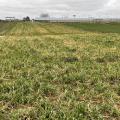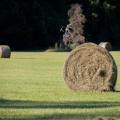Inoculation Procedure for 25 Pounds of Legume Seed
- Mix 2 ounces of syrup or molasses with 8 ounces of water. Shake or stir well, or mix 1 cup of sugar with 2 cups of water, or just use milk. Do not use cola drinks or other carbonated beverages. The pH of such beverages is near 2.0 and harmful to the rhizobia.
- Add about 1/3 bag of fresh inoculant (about 2 ounces) to about 1 cup of the sticking agents. Mix to form a black slurry.
- Place 25 pounds of seed in a tub or similar container.
- Add the black slurry (6 to 7 ounces) to the seed in the tub and thoroughly mix. Be sure to coat every seed. Add the remainder of the bag of dry inoculant to coat and dry the seeds. This inoculant rate may be several times the manufacturer’s recommended rate of inoculum.
- Allow seeds to dry in the shade. To speed the drying process, add more inoculant or a small amount of finely ground (passing 200 mesh sieve) limestone. Do not use burnt, hydrated, slaked, or builder’s lime.
- Plant inoculated seed as soon as possible or keep in cool, shaded conditions for no longer than one to three days. Do not leave the bag of inoculants or inoculated seed in direct sunlight because sunlight kills rhizobia. Do not mix inoculated seed with fertilizer. The salts and acids in the fertilizer will kill the rhizobia. Inoculated seed may be mixed with dry fertilizer if the mix is planted immediately.
- If molybdenum or fungicides are needed, apply them to seed after inoculation and plant immediately. (Generally, inoculants premixed with a fungicide and/or molybdenum have fewer viable rhizobia than other inoculants and should not be used).
Kinds of Inoculants needed for commonly grown forage legumes.
- Alfalfa Group (Rhizobium meliloti)
Alfalfa, Black medic, Burr clover (medic), Button clover (medic), Sweetclovers (yellow and white)
- Cowpea Group (Bradyrhizobium japonicim)
Alyceclover, Cowpea, Kudzu, Peanut, Lespedeza, and Lima bean
- Pea and Vetch Group (Rhizobium leguminosarum)
Bigflower vetch, Common vetch, Hairy vetch, Winter pea, Caleypea, Garden peas, Lentils
- Trefoil (Rhizobium loti)
Birdsfoot trefoil
- Clover Group (Rhizobium trifolii)
- Clover I: Berseem clover, Crimson clover, Lappa clover, Persian clover, and Rose clover.
- Clover II: Rose clover and Subterranean clover
- Clover III: Alsike clover, Ball clover, Hop clover, Ladino clover, Red clover, and White clover.
- Clover IV: Arrowleaf clover
- Lupine Group (Rhizobium lupini)
Blue lupine, White lupine
- Bean (Rhizobium japonicum)
Soybean
Publications
Publication Number: P2843
Publication Number: P2710
Publication Number: P2541
Publication Number: P2458
Publication Number: P2459
News
Filed Under: Forages, Management - Forages, Livestock
Mississippi hay growers harvested at least 28 percent less hay this year than usual because of the drought that reached extreme levels in parts of the state. Brett Rushing, Mississippi State University Extension forage agronomist, said hay producers in the state typically get three cuttings a year, and often four if they manage well and the weather cooperates.
CEDARBLUFF, Miss. – The Mississippi State University Extension Service invites producers to a field day highlighting stewardship in cattle grazing systems on June 23.





